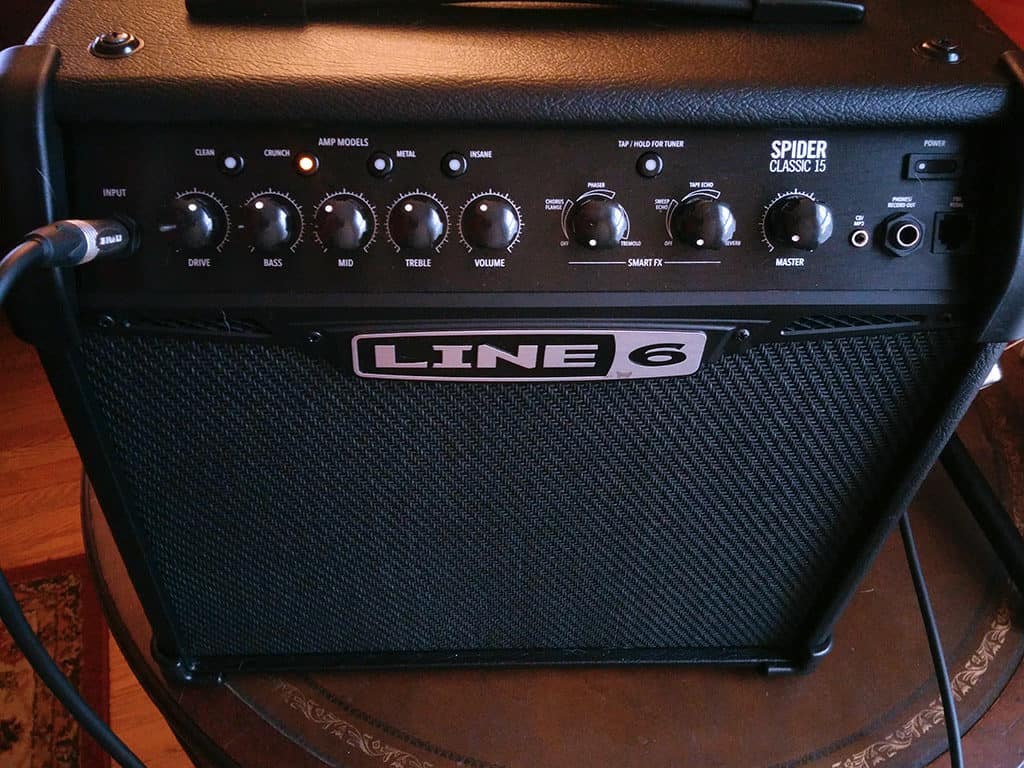Review: Line 6 Spider Classic 15 – who should use one?
Guitars are my favorite thing, especially electric ones. Alas, they are but one half of the sonic equation – they’re not worth a single thing without an amplifier for the sound to come out of.
Guitarists today are lucky. It used to be that pretty much everybody started their playing with a 10 watt, solid state amp with a six inch speaker. It would have two channels: clean and dirty.
Before we begin, make sure you’re ordering Line 6 from a legitimate retailer, NOT from a counterfeit seller. For your convenience, here is the Amazon link to an authentic Line 6 retailer.Those amps – regardless of brand – sounded nasty, and not in a good way. But that was kind of it until you could get a nice valve, or at least hybrid amp.
These days, for not a lot of money, new guitarists can get a amp that will give them a wider range of sounds, all from one box. Purists will sneer, but if you’re on a budget, these amps will truly delight you.
Amongst those, and certainly at the lower end of these kinds of amps, is the Line 6 Spider Classic 15.
Core specs
Going through the specs of the Classic, and it’s essentially a combination of an amplifier and a multi-effects unit. Nothing wrong with that.
In fact, to look at this in the context of being just an amp is to miss the point.
| What’s its output? | 15 watts | |
| Valve, solid state or hybrid? | At this price? Solid state baby… | |
| What speaker configuration does it have? | One eight inch speaker | |
| How many effects does it have? | Six | |
| How many amp models does it have? | Four |
Additionally, it comes with a built-in tuner, which I really like. I’ve seen too many bands scrabbling about looking for a tuner before – and even during – their set.
Parts
It’s important to remember that this is a cheap amp. This means that none of the parts are going to be too fancy. Add to that the fact that it’s a solid state amp, and the effects are digital, and everything points quite squarely at this being a brash and noisy little beastie.
It’s not easy to tell what kind of wood the cabinet is made from. It’s usually MDF or plywood. It comes with a classic black vinyl covering, and plastic knobs as you’d expect.
Taking a look at its front panel, we get a better idea of what it will do, and how it will do it. Apart from the obvious jack plug input for your guitar, it’s also got a jack plug output. You can use this for headphones, or as a line out if you want to record your playing directly.
We can see the four amp models available – more on them later – and the EQ controls. There’s just one set of EQ controls for each amp model, but you can save them so you don’t have to adjust them every time you change channels.
Over a bit to the right, we can see two knobs that will control six effects, which sounds tight, but you can see how they’ll work.
After that, you’ve got a master volume, a mini jack plug input for an external source for you to play along to, and a connection for a footswitch.
Construction

Despite its modest size, the Classic 15 has a decent weight behind it. It’s not any kind of a science at all into assessing its construction, but there is something comfortable about a weighty piece of kit. Perhaps it invokes a sense that it’s less likely to get knocked over?
That aside, the cabinet housing all the parts is very solid – no criticism here for that – and everything looks put together very tidily.
As with any amp, as long as you look after it – give it a clean every now and then; don’t use it as a beer stand; make sure all knobs are set to zero before turning it on or off – it shouldn’t give you any trouble.
It’s important to remember that the construction of an amp, even more so than a guitar, also includes its inside, so if you’re moving it around, be careful with it! It may not have delicate valves, but it’ll have plenty of chips boards and circuitry that may not respond well to intense shaking!
Looking at the front panel again, the layout is very standard, so nothing to criticize there.
It’s like this: Line 6 haven’t become one of the top names in amps and effects for making stuff that falls apart easily.
Tones
There’s a lot to get through in terms of tones, so I’ll try and blitz through the highlights. Obviously a lot of the tone that comes out of an amp is dependent on the electronics of the guitar that’s going into it. So, to get the best overview, I tried it with both single coil and humbucker configurations.
I’d normally set my amp EQ with the bass on four, and the treble and middle each at six. I suspected I’d have to roll off the treble a little bit.
Starting with the single coil guitar. The clean sounds weren’t bad, but it within seconds I was reaching for the treble knob to dial it off to five. Especially on the middle pickup, it pulled off some tones reminiscent of Radiohead’s cleaner moments.
On the crunch setting, I felt like it came into itself a bit more, if that makes sense? Staying on the middle pickup, it wasn’t that creamy drive you’d get from a valve amp, but it would give you a taste.
On the metal and insane settings, I didn’t spend more than a few seconds each. It just sounded awful, but who metals on a single coil guitar anyway?
Switching to my humbuckers though, that’s where the metal sounds rocked. It would be great for low volume riffage at home, and the solos weren’t bad either.
The insane setting is a bit weird. It’s just an extreme distortion. Not like a fuzz, just noisy. I didn’t like it on either guitar.
Playability
Although I certainly could pick out my favorite sounds, I’ve been playing a long time, and I knew what I was looking for.
This amp isn’t aimed at me.
For somebody who hasn’t been playing very long, I’d suggest this would be an early upgrade from whatever amp they started playing on. The effects bring another dimension, and if they haven’t got any effects pedals yet, this will at least get them thinking about ways they can color in and make their guitar sound their own.
Between the different amp models and the introduction to effects, it should encourage and inspire plenty of creativity, setting them on the path to boldly go wherever they’d like.
Conclusion
The Line 6 Spider Classic 15 is a credible amp for newbie guitarists. It’s important to reiterate that it’s not going to be the same quality of tone that you’ll get in pricier amps, even digital modeling ones.
The FBV pedal would be a useful peripheral for gigging musicians – unfortunately, a 15 watt solid state amp will be too weak for for a live music situation.
The benefit for guitarists starting on their musical journey is that it’ll give them an idea of the different kinds of amps that are available, as they get more experience and develop their own sounds.


